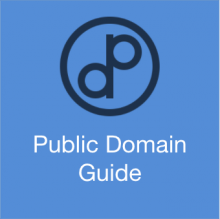What is it?
The “public domain” is all works not protected by copyright. The public owns these works; everyone can freely use them (for example: reproduce, transform, display, copy, share, or remix), but no one can exclusively own them. The public domain is a great way to get unrestricted access to creative content!
There are three types of works that enter the Public Domain:
• non-copyrightable works (such as names, familiar symbols, numbers, ideas and facts)
• works assigned to the public domain by their creators
• works with an expired copyright
What is in it?
The public domain is vast, and includes works of literature, music, film, art and other creative content. You may recognize some of these famous offerings:
• Books like Alice’s Adventures in Wonderland, by Lewis Carroll, and The Wonderful Wizard of Oz, by L. Frank Baum
• Paintings like The Mona Lisa by Leonardo da Vinci
• Characters like Robin Hood and Sherlock Holmes
• Music like Take Me Out To The Ball Game and Beethoven’s symphonies
Check out this interactive from the New York Public Library, to further explore the public domain.
Where is it?
Determining if a work is in the public domain can be tricky, even for a trained researcher! The easiest way to know for sure is to use a trusted source, such as these:
• Smithsonian Institution Public Domain Images (photographs)
• The Metropolitan Museum of Art’s Open Access (art and images)
• The Getty Museum’s Open Content (images)
• The New York Public Library’s Digital Collection (images and books)
• New York Times Public Domain Archives (news archives)
• Project Gutenberg (a electronic books)
• Librivox (audio books)
• Prelinger Archives (advertising, educational, and amateur films)

